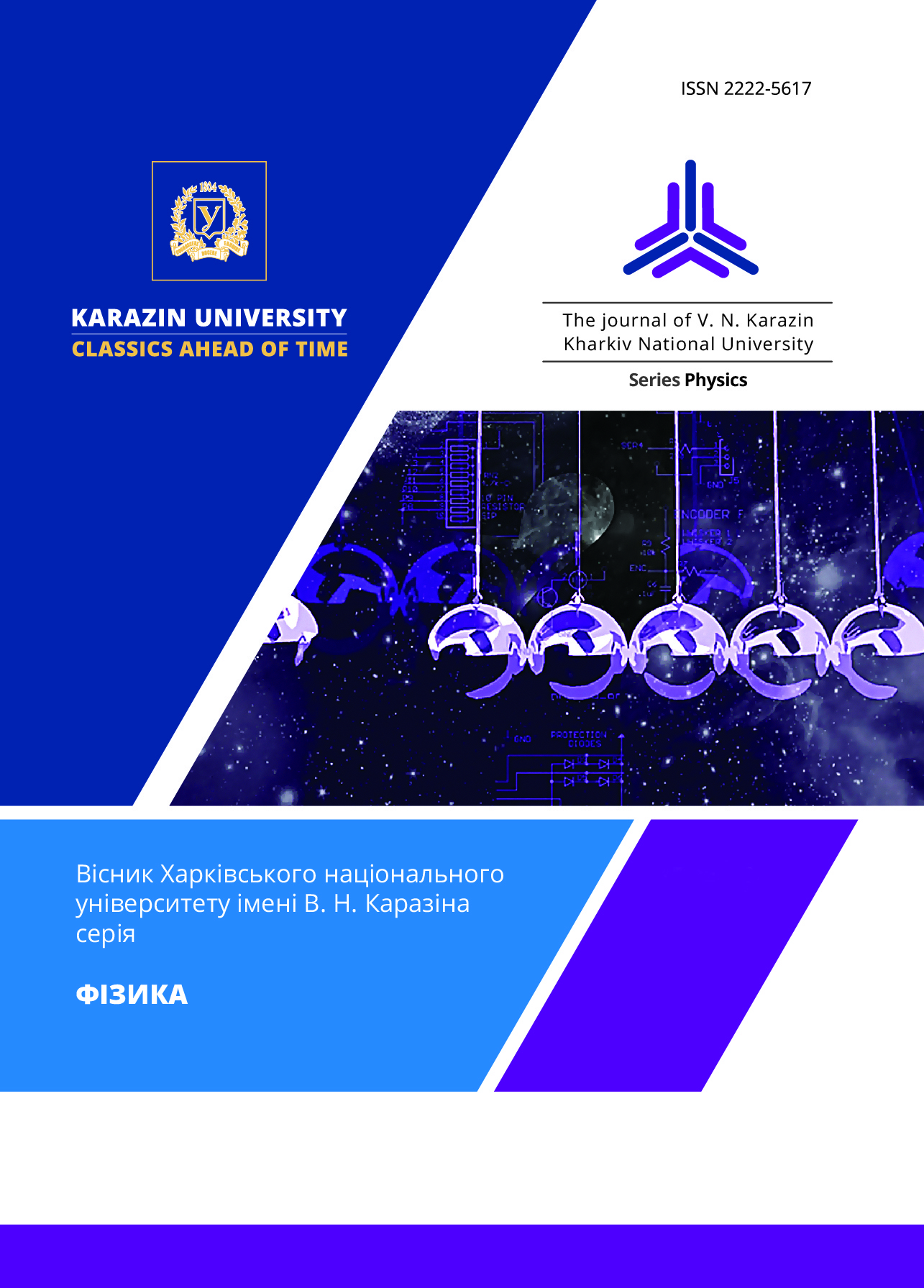ОСОБЛИВОСТІ ОЦІНЮВАННЯ ПОКАЗНИКА ХЕРСТА ДЛЯ ПРИРОДНИХ ФІЗИЧНИХ ПРОЦЕСІВ
Анотація
У відповідності до нелінійної та системної парадигм, сформульованих Л. Ф. Чорногором наприкінці 1980-х років, всі процеси у відкритих, нелінійних, динамічних системах є дуже складними, нелінійними, надширокосмуговими або фрактальними.
Як стверджує фрактальна парадигма, висунута на початку 2000-х років В. В. Яновським, фрактальність взагалі є однією із фундаментальних властивостей навколишнього світу. Тому вивчення фрактальних характеристик, зокрема, природних фізичних процесів є актуальним, цікавим і корисним.
Фрактальна розмірність, що базується на показникові Херста, є однією із найстаріших і найвідоміших. На основі дослідження модельних фрактальних сигналів продемонстровано, що залежність між оцінкою херстової фрактальної розмірності, що отримується методом нормованого розмаху, та істинним її значенням є істотно нелінійною. Для зменшення впливу похибок, що виникають у результаті цього, запропоновано використовувати метод коригуючої функції.
Продемонстровано практичну ефективність запропонованого метода на прикладі аналізу експериментальних результатів, отриманих ще в середині 1960-х років Г. Е. Херстом, який виявив наявність дещо дивного групування отриманих ним значень херстової фрактальної розмірності навколо величини 1.27 для різних природних фізичних процесів. Висунуто гіпотезу про можливість пояснення цього факту саме нелінійністю згаданої залежності для методу нормованого розмаху.
Завантаження
Посилання
B. B. Mandelbrot. The Fractal Geometry of Nature, San Francisco, CA-Freeman (1982), 460 p. https://doi.org/10.1119/1.13295
K. J. Falconer. Fractal Geometry. Mathematical Foundations and Applications, Chichester, Wiley & Sons (1990), 288 p. https://doi.org/10.1002/0470013850
J. Feder. Fractals, New York, Plenum Press (1988), 305 p. https://link.springer.com/book/10.1007/978-1-4899-2124-6
E. Chandrasekhar, V. P. Dimri, V. M. Gadre, editors. Wavelets and Fractals in Earth System Sciences, CRC Press (2014), 294 p. https://doi.org/10.1201/b16046
D. P. Feldman. Chaos and Fractals. An Elementary Introduction, Oxford, University Press (2012), 408 p. https://doi.org/10.1093/acprof:oso/9780199566433.001.0001
B. B. Mandelbrot. Fractals and Chaos: The Mandelbrot Set and Beyond, Springer (2005), 400 p. https://doi.org/10.1186/1475-925X-4-30
R. M. Crownover. Introduction to Fractals and Chaos, Boston, Jones and Barlett Publishers (1995), 320 p. https://www.amazon.com/Introduction-Fractals-Chaos-Bartlett-Mathematics/dp/0867204648
B. B. Mandelbrot. Multifractals and 1/f Noise, Springer (1999), 442 p. https://doi.org/10.1007/978-1-4612-2150-0
D. Harte. Multifractals. Theory and Applications, Boca Raton, Chapman and Hall/CRC Press (2001), 264 p. https://doi.org/10.1201/9781420036008
M. Schroeder. Fractals, Chaos, Power Laws. Minutes from Infinite Paradise, New York, W. H. Freeman and Company (1991), 528 p. https://www.amazon.com/Fractals-Chaos-Power-Laws-Infinite/dp/0486472043
F. C. Moon. Chaotic Vibrations. An Introduction for Applied Scientists and Engineers, New York, Wiley and Sons (2004), 309 p. https://doi.org/10.1002/3527602844
O. V. Lazorenko, L. F. Chernogor. Radio Phys. Radio Astron., 25 (1), 3 (2020) (in Russian). https://doi.org/10.15407/rpra25.01.003
V. V. Yanovsky. Universitates, 3, 32 (2003) (In Russian).
V. V. Yanovsky. Lectures on Nonlinear Phenomena. Volume 1, Kharkiv, Institut monokristallov Publ. (2006), 456 p. (in Russian).
L. F. Chernogor. On the Nonlinearity in Nature and Science, Kharkiv, V. N. Karazin Kharkiv National University (2008), 528 p. (In Russian).
O. V. Lazorenko, L. F. Chernogor. Radio Phys. Radio Astron., 28(1), 5 (2023) (in Ukrainian). https://doi.org/10.15407/rpra28.01.005
H. E. Hurst. Trans. Amer. Soc. Civ. Eng., 116, 770 (1951).
H. E. Hurst, R. P. Black, Y. M. Simaika. Long-term storage: an experimental study, London, Constable (1965), 145 p.
L. F. Chernogor, O. V. Lazorenko, A. A. Onishchenko. Low Temperature Physics, 49(4), 459 (2023). https://doi.org/10.1063/10.0017581
H. H. Hardy, R. A. Beier. Fractals in Reservoir Engineering. Singapore, New Jersey, London, Hong Kong, World Scientific (1994), 359 p. https://doi.org/10.1142/2574
L. Seuront. Fractals and Multifractals in Ecology and Aquatic Science, Boca Raton, London, New York, CRC Press (2010), 344 p. https://doi.org/10.1201/9781420004243
B. Mandelbrot, J. R. Wallis. Water Resources Res., 5(1) 228 (1969). https://doi.org/10.1029/WR005I001P00228
J. B. Bassingthwaighte. News Physiol. Sci., 3, 5 (1988). https://doi.org/10.1152/physiologyonline.1988.3.1.5
N. Scafetta, P. Grigolini. Phys. Rev. E, 66(3), 036130 (2002). https://doi.org/10.1103/physreve.66.036130
J. H. Van Beek, S. A. Roger, J. B. Bassingthwaighte. Am. J. Physiol., 257(5), H1670 (1989). https://doi.org/10.1152/ajpheart.1989.257.5.h1670
H. M. Hastings, G. Sugihara. Fractals: A User’s Guide for the Natural Science, Oxford, Oxford University Press (1993), 248 p. https://www.amazon.com/Fractals-Natural-Sciences-Science-Publications/dp/0198545975
R. F. Peltier, J. Lévy-Véhel. Research report, INRIA Rocqencourt (1994). https://hal.inria.fr/inria-00074279
J. Beran. Statistics for Long-Memory Processes, Chapman and Hall (1994), 328 p. https://doi.org/10.2307/2983481
C.-K. Peng, S. V. Buldyrev, S. Havlin, M. Simons, H. E. Stanley, A. L. Goldberger. Phys. Rev. E., 49, 1685 (1994). https://doi.org/10.1103/PhysRevE.49.1685
M. S. Taqqu, V. Teverovsky, W. Willinger. Fractals, 03(04), 785 (1995). https://doi.org/10.1142/s0218348x95000692
M. J. Cannon, D. B. Percival, D. C. Caccia, G. M. Raymond, J. B. Bassingthwaighte. Physica A: Statistical Mechanics and Its Applications, 241(3-4), 606 (1997). https://doi.org/10.1016/s0378-4371(97)00252-5
N. Vandewalle, M. Ausloos. Phys. Rev. E, 58(5), 6832 (1998). https://doi.org/10.1103/physreve.58.6832
A. Eke, P. Hermán, J. Bassingthwaighte, G. Raymond, D. Percival, M. Cannon, … C. Ikrényi. Pflügers Archiv - European Journal of Physiology, 439(4), 403 (2000). https://doi.org/10.1007/s004249900135
S. M. Prigarin, K. Hahn, G. Winkler. Numerical Analysis and Applications, 2(4), 352 (2009). https://doi.org/10.1134/s1995423909040077
M. A. Riley, S. Bonnette, N. Kuznetsov, S. Wallot, J. Gao. Frontiers in Physiology, 3 (2012). https://doi.org/10.3389/fphys.2012.00371
M. J. Sánchez-Granero, M. Fernández-Martínez, J. Trinidad-Segovia. The European Physical Journal B, 85(3), 86 (2012). https://doi.org/10.1140/epjb/e2012-20803-2
T. Gneiting, H. Sevcikova and D. B. Percival. Statist. Sci., 27, 247 (2012). https://doi.org/10.1214/11-STS370
M. S. Taqqu. Stochastic Processes and Their Applications, 7(1), 55 (1978). https://doi.org/10.1016/0304-4149(78)90037-6
H. E. Hurst, R. P. Black, Y. M. Simaika. Long-term storage: an experimental study, London, Constable (1965), 145 p. https://doi.org/10.2307/2982267
O. V. Lazorenko, A. A. Onishchenko, L. F. Chernogor. Radiotekhnika: All-Ukr. Sci. Inter- dep. Mag., 210. 177 (2022). (in Ukrainian). https://doi.org/10.30837/rt.2022.3.210.15.
C. Bandt, M. Barnsley, R. Devaney, K. J. Falconer, V. Kannan, P. B. Vinod Kumar, editors. Fractals, Wavelets, and their Applications: Contributions from the Int. Conference and Workshop on Fractals and Wavelets (Springer Proceedings in Mathematics & Statistics), Switzerland, Springer Int. Publ. (2014), 508 p. https://www.amazon.com/Fractals-Wavelets-their-Applications-Contributions-ebook/dp/B00PUM0AQ2








3.gif)
